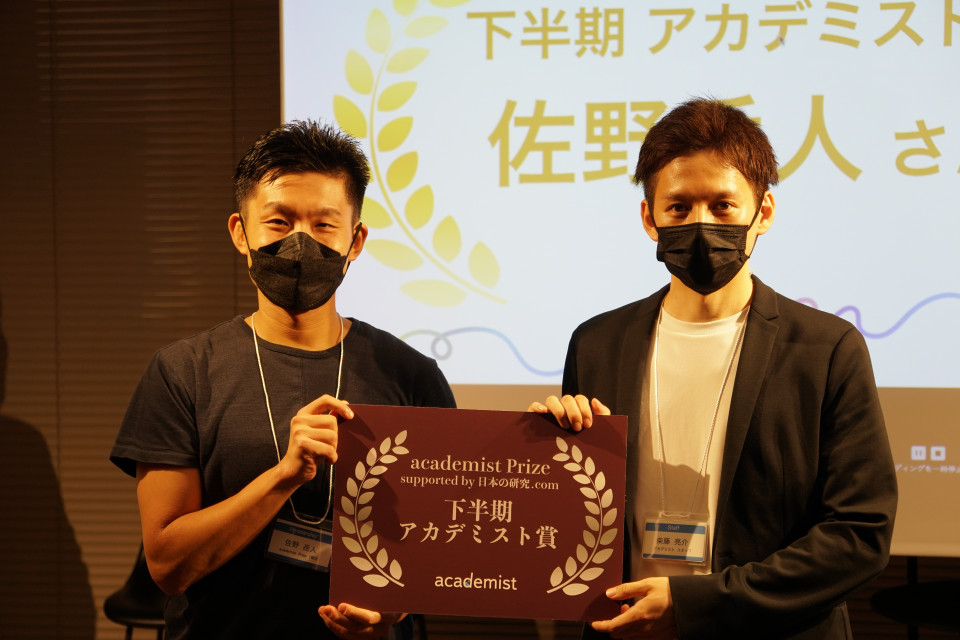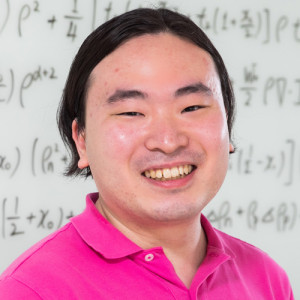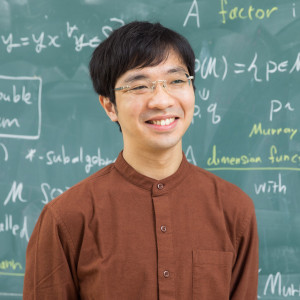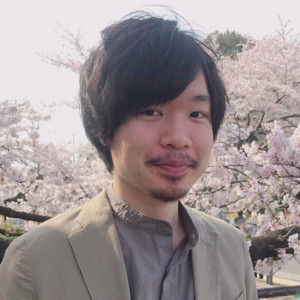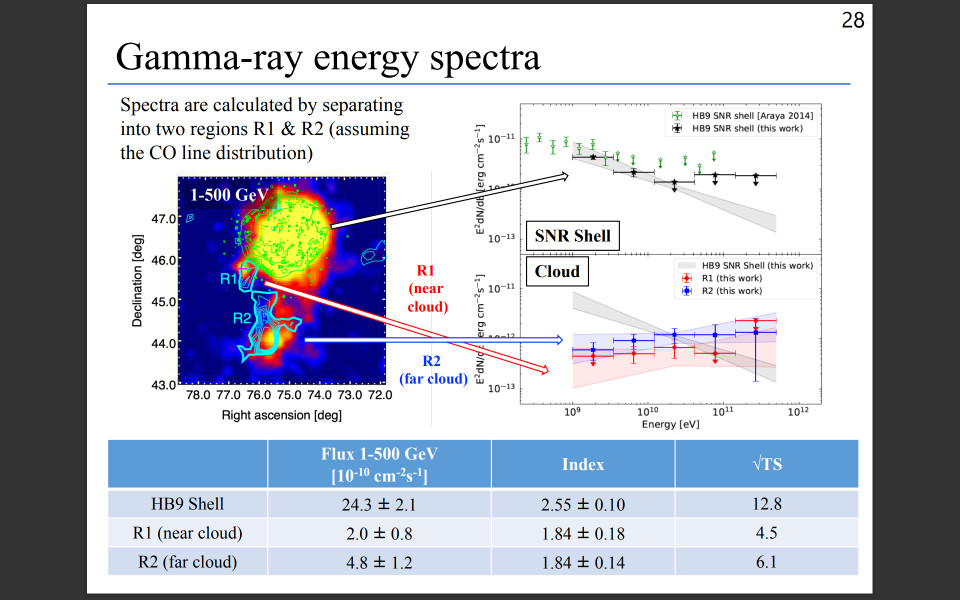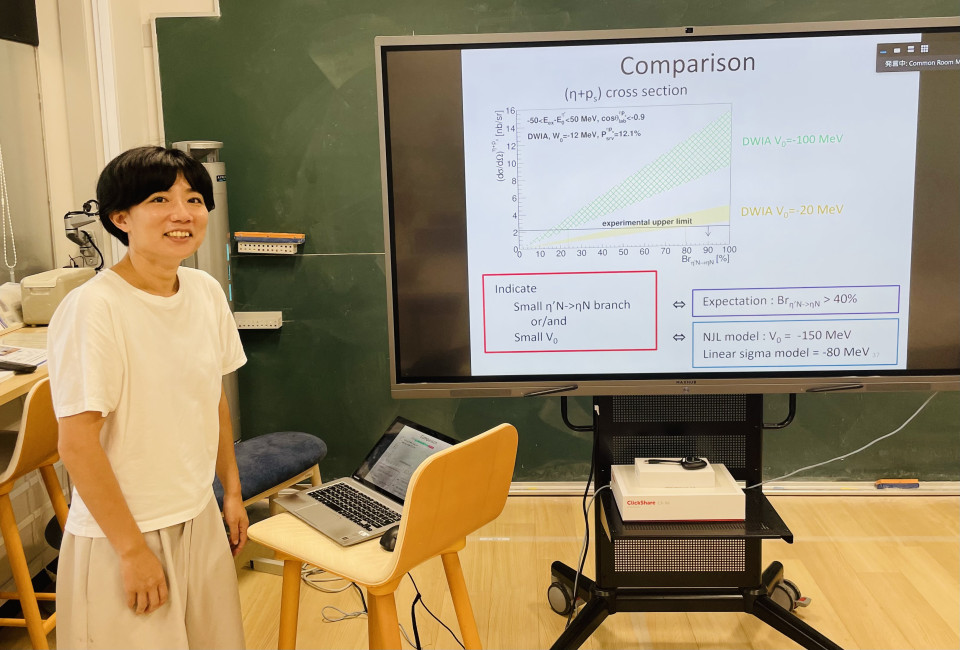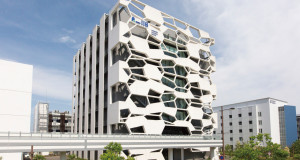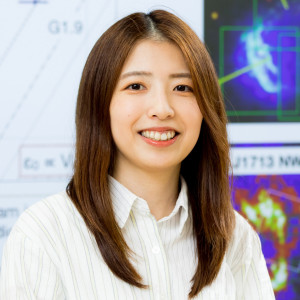Volume 215
Back to Newsletter List
Award
Dr. Taketo Sano received the "academist Prize 2022"
2022-09-05
On Aug.31, 2022, Taketo Sano (iTHEMS) received the "academist Prize 2022" at the event "academist Prize 2022 FINAL" where young researchers gather to discuss the future 30 years from now. Congratulations, Taketo!
Award
Dr. Tomoya Naito received 2022 RIBF Users Group Thesis Award
2022-09-06
It is our greatest pleasure to inform you that our iTHEMS colleague, Tomoya Naito, received the "2022 RIBF Users Group Thesis Award". The awards honor the achievement of young scholars who earned the doctoral degree based on an RIBF experiment (using BigRIPS, GARIS, CRIB, RIPS, etc.), or a theoretical study related to physics at RIBF. The prize ceremony will be held on Sept. 20, 2022 at the annual RIBF Users Meeting.
Award
Dr. Michiya Mori received 2022 Takebe Katahiro Prize for Encouragement of Young Researchers
2022-09-06
It is our greatest pleasure to inform you that our iTHEMS colleague, Michiya Mori, received 2022 Takebe Katahiro Prize for Encouragement of Young Researchers from The Mathematical Society of Japan (MSJ) for his contribution to the "Studies on preserver problems on operator algebras”. This prize was established by MSJ in honor of the renowned Japanese Mathematician in Edo period, Katahiro Takeba (1664 –1739).
Award
Dr. Shou Yoshikawa received 2022 Takebe Katahiro Prize for Encouragement of Young Researchers
2022-09-06
It is our greatest pleasure to inform you that our iTHEMS colleague, Shou Yoshikawa, received 2022 Takebe Katahiro Prize for Encouragement of Young Researchers from The Mathematical Society of Japan (MSJ) for his contribution to the "Studies on algebraic varieties admitting a polarized endomorphism and the minimal model theory in mixed characteristic”. This prize was established by MSJ in honor of the renowned Japanese Mathematician in Edo period, Katahiro Takeba (1664 –1739).
Seminar Report
ABBL-iTHEMS Joint Astro Seminar by Dr. Tomohiko Oka on September 2, 2022
2022-09-05
Supernova remnants (SNRs) are believed to be the site of cosmic ray acceleration up to PeV (called PeVatron), but there is no conclusive observational evidence. The possible reason is that only young SNRs (t_age < 1 kyr) can accelerate CRs up to PeV, and then the particles escape at the early stage, thus, the opportunity to observe them is limited. To investigate this scenario, Oka-san and his collaborators observed and analyzed the following two SNRs. First, they focused on SNR G106.3+2.7, the most promising SNR as a PeVatron, since 100 TeV gamma rays have been detected with air shower experiments. With the gamma-ray observation results, they discussed the origin of the PeV CR in the vicinity of this middle-aged SNR (t_age = 5-10 kyr) and then obtained the following interpretation: CRs accelerated at the SNR in the past are illuminating the molecular cloud and producing gamma rays at present. Second, they analyzed the observation data around SNR HB9 and newly found gamma-ray emissions outside the SNR shell at the molecular cloud region. The gamma-ray emission can be explained by the protons accelerated and escaped from the SNR in the past. Therefore, they have attempted to measure the time evolution of the maximum acceleration energy at the SNR by comparing the gamma-ray spectra at the SNR shell and cloud regions. In this seminar, Oka-san reported the analysis results of those two SNRs. Following the seminar talk, we discussed about the SNRs and high-energy gamma-rays from them.
Reported by Shigehiro Nagataki
Search for Galactic SNR PeVatrons: γ-ray observations in the vicinity of SNRs G106.3+2.7 & HB9
September 2 (Fri) 14:00 - 15:00, 2022
Seminar Report
iTHEMS-RNC Meson Science Lab. Joint Seminar by Dr. Natsuki Tomida on August 26, 2022
2022-09-05
Natsuki Tomida (SACRA, Kyoto Univ.) gave a hybrid talk on her experimental research on the bound eta'-meson in nuclei. This is related to the topic "Mesons in Nuclei" which is one of the central subjects in modern hadron physics. Both experimentalists and theorists from Nishina Center and iTHEMS joined the seminar, and there was a hot discussion on this interesting topic. Natsuki joined iTHEMS on Aug.1, 2022 as a visiting scientist to promote collaboration between SACRA's MACS program at Kyoto Univ. and RIKEN iTHEMS. On Sept. 20-21, 2022, she will visit iTHEMS again together with 11 undergraduate and graduate students of Kyoto University.
Reported by Tetsuo Hatsuda
Study of the eta' meson in nuclei in the LEPS2/BGOegg experiment
August 26 (Fri) 16:30 - 18:00, 2022
Upcoming Events
Workshop
DM3 - Deep insights and Multiple strategies for Deciphering the Mystery of Dark Matter
September 15 (Thu) - 17 (Sat) 2022
Venue: SUURI-COOL (Kobe), Room S704-S705, Integrated Innovation Building (IIB), Kobe Campus, RIKEN / via Zoom
Event Official Language: English
Seminar
Quantum Matter Seminar
Phantom Bethe excitations and spin helices in integrable spin chains
September 15 (Thu) 17:00 - 18:15, 2022
Vladislav Popkov (University Wuppertal, Germany)
We demonstrate the existence of a special chiral “phantom” mode with some analogy to a Goldstone mode in the anisotropic quantum XXZ Heisenberg spin chain. The phantom excitations contribute zero energy to the eigenstate, but a finite fixed quantum of momentum. The mode exists not due to symmetry principles, but results from nontrivial scattering properties of magnons with momentum k given by the anisotropy via cos (k) = Jz/Jx. The mode originates from special string-type solutions of the Bethe ansatz equations with unbounded rapidities, the phantom Bethe roots. All such Bethe states are chiral (the simplest representative being factorized state with helicoidal magnetization profile) and exist in both periodic and open XXZ spin chain under fine-tuning. I show how phantom Bethe states can be generated dissipatively, by setting a polarization gradient via coupling the ends of the open spin chain to suitable dissipative baths. Spin helix eigenstates were observed and used in recent cold atom experiments, and led to further surprising findings.
Venue: via Zoom
Event Official Language: English
Seminar
ABBL-iTHEMS Joint Astro Seminar
MeV gamma-ray all sky simulation
September 16 (Fri) 14:00 - 15:00, 2022
Naomi Tsuji (Assistant Professor, Faculty of Science, Kanagawa University)
The MeV gamma-ray domain is the only unexplored window among recent multiwavelength observations in astrophysics, often referred to as the "MeV gap". To fulfill this gap, there are several ongoing and planned projects of MeV gamma-ray telescopes. The measurement of MeV gamma rays (both continuum and line emission) would give us new insight into many topics in astrophysics, such as relativistic jets, particle acceleration, and origin of matter. In advance of the future MeV gamma-ray missions, we have been working on prediction of the MeV gamma-ray sky, which is helpful to determine what kinds of sources can be detectable with the future telescopes. In order to explore the MeV gamma-ray sources, we performed a catalog cross-matching between the hard X-ray (Swift/BAT) and GeV gamma-ray (Fermi/LAT) catalogs, resulting in 145 firmly cross-matched sources. Combined with the Galactic diffuse emission, which is calculated by GALPROP to reconcile the cosmic-ray and gamma-ray spectra with observations by AMS-02, Voyager, and Fermi-LAT, the all-sky maps in the MeV gamma-ray band can be produced. This is also used to investigate a long-standing problem in the MeV gamma-ray astrophysics: the origin of the diffuse emission from the inner Galaxy, measured by COMPTEL. I will report the analysis and results in detail, and introduce future missions of the MeV gamma-ray detectors.
Venue: via Zoom
Event Official Language: English
Seminar
ABBL-iTHEMS Joint Astro Seminar
Hyperons in neutron stars: fast cooling, Joule heating and hyperon superfluidity
September 26 (Mon) 14:00 - 15:00, 2022
Filippo Anzuini (Postdoc Fellow, Department of Astronomy, Monash University, Australia)
Neutron stars challenge current models of highly dense matter. Despite be- ing the targets of numerous observational campaigns (e.g. gravitational-wave searches and X-ray observations), their equation of state is still unknown. One of the most exciting possibilities is that “unconventional” particles such as hy- perons may appear in neutron star cores. Hyperons have a major impact on the observed thermal luminosity, because they accelerate the cooling rate via direct Urca processes, which copiously increase the neutrino emission from the core. Such mechanism is often considered to be a key signature of hyperon concentrations at high densities. Hyperon superfluidity plays a major role as well, because it can suppress the neutrino emissivity exponentially. The hope is that a comparison of the theoretical cooling curves against the available data of thermally-emitting neutron star can hint towards the existence of hyperons and their superfluidity. There is one ingredient, however, that is often neglected in neutron star cooling models: internal heating. The magnetic field of neutron stars decays due to the dissipation of the electric currents circulating in the crust, generating substantial Joule heating in the shallower layers. The ther- mal power generated by this process can counterbalance hyperon fast cooling, making it difficult to infer the presence of hyperons from the available thermal luminosity data, and complicating the link between measured thermal emission and internal composition. We show that this is the case for magnetars, because their crustal temperature is almost independent of hyperon direct Urca cooling in the core, regardless of whether hyperons are superfluid or not. Likewise, ther- mal luminosity data of moderately magnetized neutron stars are not suitable to extract information about the internal composition, as long as hyperons are superfluid.
Venue: Hybrid Format (Common Room 246-248 and Zoom)
Event Official Language: English
Seminar
iTHEMS Seminar
Axion electrodynamics in neutron stars
September 27 (Tue) 14:00 - 15:00, 2022
Filippo Anzuini (Postdoc Fellow, Department of Astronomy, Monash University, Australia)
Axions are pseudo-Goldstone bosons that provide a solution to the strong CP problem, and are prominent candidates for dark matter. In neutron stars, it has been shown recently that the potential of the QCD axion acquires finite density corrections that shift the axion field expectation value, which can be large compared to the vanishing expectation value in vacuo. Such a shift leaves an imprint on typical neutron star observables such as the redshifted thermal luminosity, which can be used to constrain the axion parameter space. In this talk we focus on the coupling of axions with photons, which modifies Maxwell’s equations and alters the neutron star magnetic field. By performing state-of-the-art magneto-thermal simulations, we calculate the axion-induced perturbations to the neutron star’ magnetic field, and show that they grow on relatively short time-scales. At the same time, intense electric currents form, leading to enhanced ohmic dissipation, which increases the stars’ observable thermal luminosity. The activation of such mechanisms depends on the axion decay constant and the axion mass, two long-sought parameters at the center of several experimental and theoretical investigations. Both parameters can be constrained by comparing our simulations to observations of thermally-emitting neutron stars. The latter do not exhibit uncontrolled growth of the magnetic field that causes enhanced ohmic dissipation, allowing us to place bounds on axion parameters. Our results open a new astrophysical avenue to constrain axions, extending significantly the parameter range that can be probed with direct axion searches.
Venue: Hybrid Format (Common Room 246-248 and Zoom)
Event Official Language: English
Paper of the Week
Week 2, September 2022
2022-09-08
Title: Comparative Study on Charge Radii and Their Kinks at Magic Numbers
Author: Tomoya Naito, Tomohiro Oishi, Hiroyuki Sagawa, Zhiheng Wang
arXiv: http://arxiv.org/abs/2209.02857v1
Title: Establishment of an allotetraploid fern species, Lepisorus yamaokae Seriz., between two highly niche-differentiated parental species
Author: Tao Fujiwara, Tsubasa Egashira, José Said Gutiérrez-Ortega, Kiyotaka Hori, Atsushi Ebihara, Yasuyuki Watano
Journal Reference: American Journal of Botany
doi: https://doi.org/10.1002/ajb2.16043
Title: Linear confinement in the partially-deconfined phase
Author: Vaibhav Gautam, Masanori Hanada, Jack Holden, Enrico Rinaldi
arXiv: http://arxiv.org/abs/2208.14402v1
If you would like to cancel your subscription or change your email address,
please let us know via our contact form.
Copyright © iTHEMS, RIKEN. All rights reserved.


